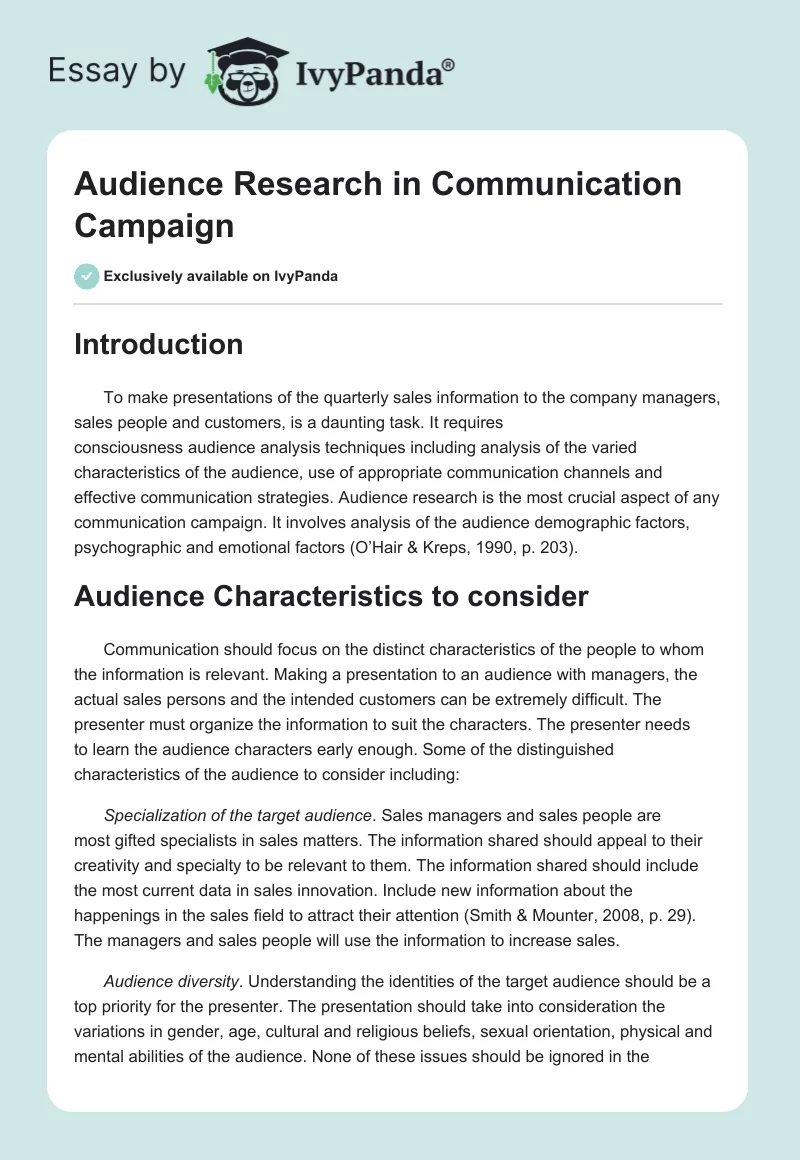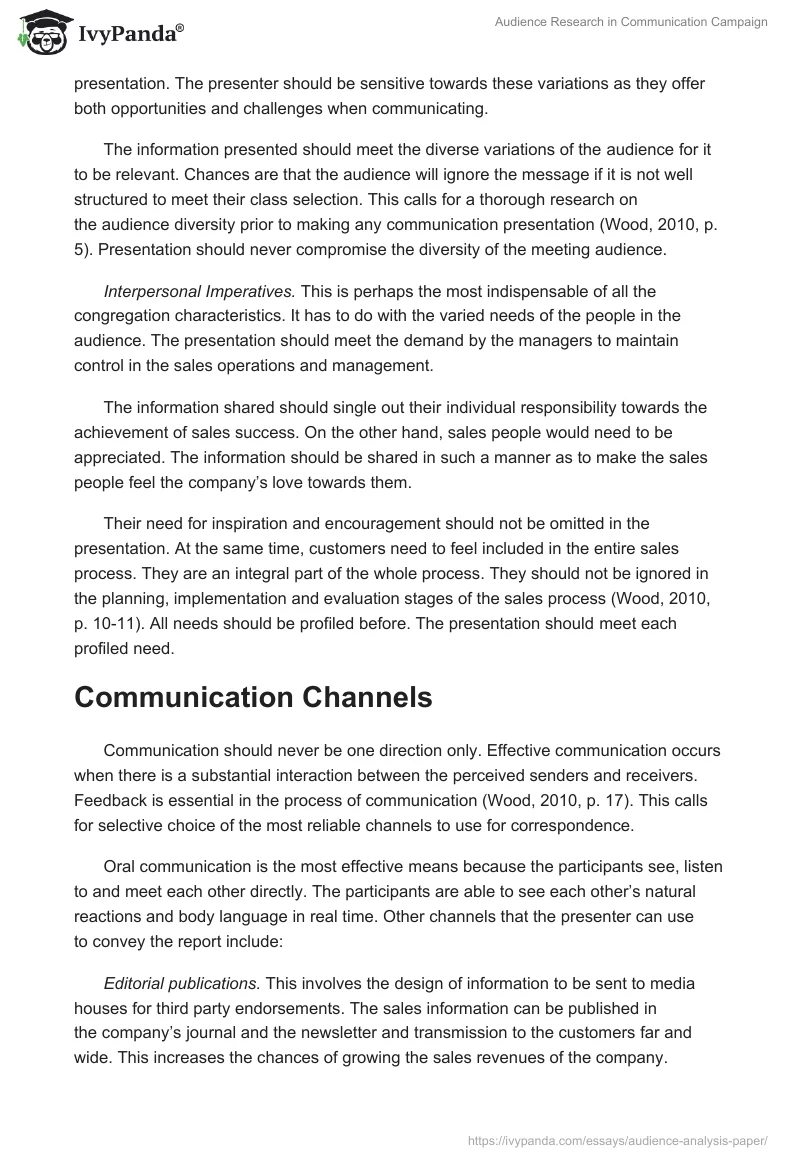Introduction
To make presentations of the quarterly sales information to the company managers, sales people and customers, is a daunting task. It requires consciousness audience analysis techniques including analysis of the varied characteristics of the audience, use of appropriate communication channels and effective communication strategies. Audience research is the most crucial aspect of any communication campaign. It involves analysis of the audience demographic factors, psychographic and emotional factors (O’Hair & Kreps, 1990, p. 203).
Audience Characteristics to consider
Communication should focus on the distinct characteristics of the people to whom the information is relevant. Making a presentation to an audience with managers, the actual sales persons and the intended customers can be extremely difficult. The presenter must organize the information to suit the characters. The presenter needs to learn the audience characters early enough. Some of the distinguished characteristics of the audience to consider including:
Specialization of the target audience. Sales managers and sales people are most gifted specialists in sales matters. The information shared should appeal to their creativity and specialty to be relevant to them. The information shared should include the most current data in sales innovation. Include new information about the happenings in the sales field to attract their attention (Smith & Mounter, 2008, p. 29). The managers and sales people will use the information to increase sales.
Audience diversity. Understanding the identities of the target audience should be a top priority for the presenter. The presentation should take into consideration the variations in gender, age, cultural and religious beliefs, sexual orientation, physical and mental abilities of the audience. None of these issues should be ignored in the presentation. The presenter should be sensitive towards these variations as they offer both opportunities and challenges when communicating.
The information presented should meet the diverse variations of the audience for it to be relevant. Chances are that the audience will ignore the message if it is not well structured to meet their class selection. This calls for a thorough research on the audience diversity prior to making any communication presentation (Wood, 2010, p. 5). Presentation should never compromise the diversity of the meeting audience.
Interpersonal Imperatives. This is perhaps the most indispensable of all the congregation characteristics. It has to do with the varied needs of the people in the audience. The presentation should meet the demand by the managers to maintain control in the sales operations and management.
The information shared should single out their individual responsibility towards the achievement of sales success. On the other hand, sales people would need to be appreciated. The information should be shared in such a manner as to make the sales people feel the company’s love towards them.
Their need for inspiration and encouragement should not be omitted in the presentation. At the same time, customers need to feel included in the entire sales process. They are an integral part of the whole process. They should not be ignored in the planning, implementation and evaluation stages of the sales process (Wood, 2010, p. 10-11). All needs should be profiled before. The presentation should meet each profiled need.
Communication Channels
Communication should never be one direction only. Effective communication occurs when there is a substantial interaction between the perceived senders and receivers. Feedback is essential in the process of communication (Wood, 2010, p. 17). This calls for selective choice of the most reliable channels to use for correspondence.
Oral communication is the most effective means because the participants see, listen to and meet each other directly. The participants are able to see each other’s natural reactions and body language in real time. Other channels that the presenter can use to convey the report include:
Editorial publications. This involves the design of information to be sent to media houses for third party endorsements. The sales information can be published in the company’s journal and the newsletter and transmission to the customers far and wide. This increases the chances of growing the sales revenues of the company.
Equipment aided communications. The presenter can use equipments such as the projectors, computers and computer applications such as power point to make excellent presentations. Equipments help present information orally given during the presentation. This method is reasonable, productive and recommendable.
What to consider when making the presentation
Internal communication is key to the performance of any organization or company. The responsibility for internal communication lies with all the different stakeholders of the company. The presentation should keep in mind the following: The presentation should point people on the shared.
The most salient aspect of the communication should be the impact on people and not the phenomenon known as sales. The importance of all the people stakeholders should come out in the presentation. This guarantees continued shopping and consumption of the products and services by the customers. It also motivates the sales teams, supervisors, managers and the company shareholders (Smith & Mounter, 2008 p. 16).
Internal communication is crucial to business success.The presentation aims at helping the audiences (participants) get their role towards the results projected. This ensures the discussion is more fruitful. The crucial role played by or that should be played by the staff and the customers should come out when sharing the quarterly sales figures. Expectations and the general guiding principles for each category of the audience should be clarified.
How to ensure your message is effective
One will never be able to communicate effectively without designing appropriate communication techniques and strategies. The presenter must ensure that the communication strategy meets three main characteristics: (O’Hair & Kreps, 1990, p. 135). It must be relevant to the audience under question.
The presentation should answer the existing needs of the audience and the company at large. Information shared should be edited to suit the purpose of the presentation. This minimizes the problem of redundancy in communication.
The strategy used should ensure audience comfort. The choice of the environment should not impede communication. The language and the audience participation participation methods used should be easy to the audience. The presenter should reduce audience fear and anxiety using ice breakers.
Lastly, the presentation should be made using diverse methodologies. Different communication strategies should be used considering the audience types, their communication needs and the overall goals and objectives of the presentation. The person making the submission should determine whether to use behavioral rehearsals (role playing), bibliotherapy or case study analysis. The option which enables more people to participate in the conversation is more effective.
Conclusion
Effective communication should provide a chance for feedback. It should meet all the needs of the audience without compromising their salient characteristics. It should incorporate well thought of communication channels. It should be relevant.
References
O’Hair, D. & Kreps, G.L. (1990). Applied Communication Theory and Research. New Jersey: Lawrence Erlbaum Associates Inc Publishers.
Smith, L. & Mounter, P. (2008). Effective Internal Communication. London: Kogan Page Limited.
Wood, J.T. (2010). Interpersonal Communication – Every Encounter. Boston: Wordsworth Cengage Learning.


